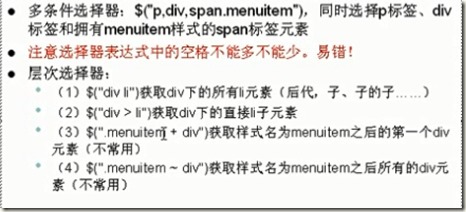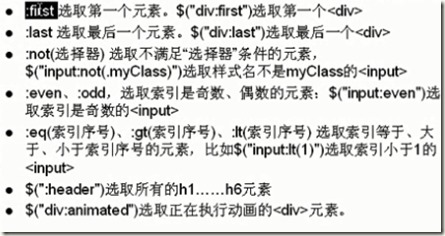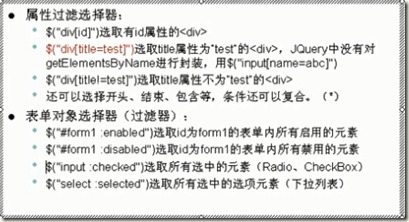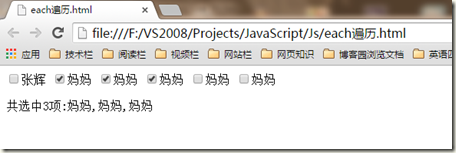JQuery learning summary
JQuery learning summary [1]
1: JQuery
1 JQuery knowledge
*: Let us learn to call the JQ plug-in, which is actually an encapsulation of JS internally.
*: There are three files in jquery.

The second and third files actually have the same content, but the third one has been compressed to shorten the browser's access time. .
We put Jquery-1.4.2.js and jquery.1.4.2-vsdoc and js together when using them. In fact, vsdoc.js is the explanation for the previous explanation. It allows us to write code. Click to operate.
*: Practice "Click the button to pop up the content of the dialog box" "Click the text in the web page to make the text disappear line by line" ("$" is actually a function)
<head>
<script type="text/javascript" src="js/jquery-1.4.2.js"></script>
<script type="text/javascript">
$(function() {
$("#btn").click(function () { alert($("#un").val()); });//点击弹出内容
$("div").click(function() { $(this).hide("slow"); });//文字消失
});
</script>
</head>
<body>
<input type="text"id="un"/>
<input type="button" id="btn"/>
<div>文字内容</div>
</body>2 Ready in JQuery "Pop up at the beginning of the web page" Content》
$(dounction).ready(function(){alert("Loading completed");})
In fact, you can also write it like this
$(function(){alert("Loading completed");} );
3 jquery built-in function
.map(array,fn) calls the fn function to process each element in the array. The fn function will process and return, and finally get a new array. .map(array,fn) calls the fn function to process each element in the array. The fn function returns the processing and finally gets a new array. map cannot handle Dictionary-style arrays. Use the following $.each to process.
$.each(array.fn) calls the fn function to process each element of the array arr, with no return value.
var arr=[3,5,7];
Var arr2=$map.(arr,function(item){return item*2}) 函数式编程。
Var arr={“tom”;”檀木”,”xiaozhang”;”小张”}
$.each(arr,function(key,value){alert(key+”=”+value);});4 JQuery object, Dom object
The Jquery object is generated by wrapping the Dom object through jquery. And jquery objects can only call methods encapsulated by jquery objects. Methods of Dom objects cannot be called.
$(function(){$("#id").css("background","red")});
The above code is copied, which is to set the background color to red. If in .css If the attribute is one, the value is obtained, and if there are two attributes, the value is set.
5 jquery selector
*id selector
$("#div").html();
*TabName selector
$("div").click( function(){alert("Hello, I am p");});
Here is to select all the div tags in the web page and add click events to them.
* css selector
Selecting multiple styles at the same time is to add customized styles.
$(“div”).click(function(){alert(“This is information”)});
6 Multi-condition selector/hierarchical selector

7 jquery iteration
That’s it The error program will not give an error prompt. We need to add if/elae statements to make judgments.

8 jquery’s node traversal
uses the next() and nextall() methods to traverse. It's the same as traversing the array. Here we just get the value of its next element.
Siblings(): Get the sibling elements (sibling nodes) of all elements.
*: jquery’s chain programming
$("div").click(function(){
$(this).css("background","red").siblings("div").css("background","white")
});is easy to operate through the dot operator.
//This is a chain operation, which reduces the use of if/else and other operations. Changed programming style.
<!DOCTYPE html>
<html xmlns="http://www.w3.org/1999/xhtml">
<head>
<meta charset="utf-8" />
<title></title>
<script src="js/jquery-1.4.2-vsdoc.js"></script>
<script src="js/jquery-1.4.2.js"></script>
<script type="text/javascript">
$(function() {
$("#tables td").html("<img src="/static/imghw/default1.png" data-src="https://img.php.cn//upload/image/542/400/627/1480729643660472.jpg" class="lazy" src='images/1.jpg'/ alt="JQuery learning summary" >")
.mouseover(function () {
$("#tables td") .html("<img src="/static/imghw/default1.png" data-src="https://img.php.cn//upload/image/542/400/627/1480729643660472.jpg" class="lazy" src='images/1.jpg'/ alt="JQuery learning summary" >");
$(this).nextAll().html("<img src="/static/imghw/default1.png" data-src="https://img.php.cn//upload/image/542/400/627/1480729643660472.jpg" class="lazy" src='images/2.jpg'/");
});
});
</script>
</head>
<body>
<table id="tables">
<tr><td></td><td></td><td></td><td></td></tr>
</table>
</body>
</html>9: Basic filters

You can write them together here, such as selectors and filters, which will be very powerful.
You can not only use the selector for absolute positioning, but also for relative positioning. Just specify the second parameter in $(), and the second parameter is a relative element.
Case:

(relative positioning)

: The element here is the positioning of td under positioning #tables tr
10 attribute filter

Eg:
<!DOCTYPE html>
<html xmlns="http://www.w3.org/1999/xhtml">
<head>
<meta charset="utf-8" />
<script src="js/jquery-1.4.2.js"></script>
<script src="js/jquery-1.4.2-vsdoc.js"></script>
<title></title>
<script type="text/javascript">
$(function() {
$("input[value=显示选中的内容]").click(function() {
alert($("input:checked").val());
});
});
</script>
</head>
<body>
<input type="checkbox" value="上海"/>上海<br/>
<input type="checkbox" value="宝鸡"/>宝鸡<br/>
<input type="checkbox" value="深圳"/>深圳<br/>
<input type="checkbox" value="西安"/>西安<br/>
<input type="checkbox" value="北京"/>北京<br/>
<input type="submit" value="显示选中的内容"/>
</body>
</html>11 Each element of each
<!DOCTYPE html>
<html xmlns="http://www.w3.org/1999/xhtml">
<head>
<meta charset="utf-8" />
<script src="js/jquery-1.4.2.js"></script>
<script src="js/jquery-1.4.2-vsdoc.js"></script>
<title></title>
<script type="text/javascript">
$(function() {
$("input[name=names]").click(function() {
var arr = new Array();
$("input[name=names]:checked").each(function (key, value) {
arr[key] = $(value).val();
});
$("#msgNames").text("共选中"+arr.length+"项:"+arr.join(","));
});
});
</script>
</head>
<body>
<input type="checkbox" name="names" value="张辉"/>张辉
<input type="checkbox" name="names" value="妈妈"/>妈妈
<input type="checkbox" name="names" value="妈妈"/>妈妈
<input type="checkbox" name="names" value="妈妈"/>妈妈
<p id="msgNames"></p>
</body>

Hot AI Tools

Undresser.AI Undress
AI-powered app for creating realistic nude photos

AI Clothes Remover
Online AI tool for removing clothes from photos.

Undress AI Tool
Undress images for free

Clothoff.io
AI clothes remover

AI Hentai Generator
Generate AI Hentai for free.

Hot Article

Hot Tools

Notepad++7.3.1
Easy-to-use and free code editor

SublimeText3 Chinese version
Chinese version, very easy to use

Zend Studio 13.0.1
Powerful PHP integrated development environment

Dreamweaver CS6
Visual web development tools

SublimeText3 Mac version
God-level code editing software (SublimeText3)

Hot Topics
 1378
1378
 52
52
 Detailed explanation of jQuery reference methods: Quick start guide
Feb 27, 2024 pm 06:45 PM
Detailed explanation of jQuery reference methods: Quick start guide
Feb 27, 2024 pm 06:45 PM
Detailed explanation of jQuery reference method: Quick start guide jQuery is a popular JavaScript library that is widely used in website development. It simplifies JavaScript programming and provides developers with rich functions and features. This article will introduce jQuery's reference method in detail and provide specific code examples to help readers get started quickly. Introducing jQuery First, we need to introduce the jQuery library into the HTML file. It can be introduced through a CDN link or downloaded
 How to use PUT request method in jQuery?
Feb 28, 2024 pm 03:12 PM
How to use PUT request method in jQuery?
Feb 28, 2024 pm 03:12 PM
How to use PUT request method in jQuery? In jQuery, the method of sending a PUT request is similar to sending other types of requests, but you need to pay attention to some details and parameter settings. PUT requests are typically used to update resources, such as updating data in a database or updating files on the server. The following is a specific code example using the PUT request method in jQuery. First, make sure you include the jQuery library file, then you can send a PUT request via: $.ajax({u
 In-depth analysis: jQuery's advantages and disadvantages
Feb 27, 2024 pm 05:18 PM
In-depth analysis: jQuery's advantages and disadvantages
Feb 27, 2024 pm 05:18 PM
jQuery is a fast, small, feature-rich JavaScript library widely used in front-end development. Since its release in 2006, jQuery has become one of the tools of choice for many developers, but in practical applications, it also has some advantages and disadvantages. This article will deeply analyze the advantages and disadvantages of jQuery and illustrate it with specific code examples. Advantages: 1. Concise syntax jQuery's syntax design is concise and clear, which can greatly improve the readability and writing efficiency of the code. for example,
 How to remove the height attribute of an element with jQuery?
Feb 28, 2024 am 08:39 AM
How to remove the height attribute of an element with jQuery?
Feb 28, 2024 am 08:39 AM
How to remove the height attribute of an element with jQuery? In front-end development, we often encounter the need to manipulate the height attributes of elements. Sometimes, we may need to dynamically change the height of an element, and sometimes we need to remove the height attribute of an element. This article will introduce how to use jQuery to remove the height attribute of an element and provide specific code examples. Before using jQuery to operate the height attribute, we first need to understand the height attribute in CSS. The height attribute is used to set the height of an element
 jQuery Tips: Quickly modify the text of all a tags on the page
Feb 28, 2024 pm 09:06 PM
jQuery Tips: Quickly modify the text of all a tags on the page
Feb 28, 2024 pm 09:06 PM
Title: jQuery Tips: Quickly modify the text of all a tags on the page In web development, we often need to modify and operate elements on the page. When using jQuery, sometimes you need to modify the text content of all a tags in the page at once, which can save time and energy. The following will introduce how to use jQuery to quickly modify the text of all a tags on the page, and give specific code examples. First, we need to introduce the jQuery library file and ensure that the following code is introduced into the page: <
 Use jQuery to modify the text content of all a tags
Feb 28, 2024 pm 05:42 PM
Use jQuery to modify the text content of all a tags
Feb 28, 2024 pm 05:42 PM
Title: Use jQuery to modify the text content of all a tags. jQuery is a popular JavaScript library that is widely used to handle DOM operations. In web development, we often encounter the need to modify the text content of the link tag (a tag) on the page. This article will explain how to use jQuery to achieve this goal, and provide specific code examples. First, we need to introduce the jQuery library into the page. Add the following code in the HTML file:
 How to tell if a jQuery element has a specific attribute?
Feb 29, 2024 am 09:03 AM
How to tell if a jQuery element has a specific attribute?
Feb 29, 2024 am 09:03 AM
How to tell if a jQuery element has a specific attribute? When using jQuery to operate DOM elements, you often encounter situations where you need to determine whether an element has a specific attribute. In this case, we can easily implement this function with the help of the methods provided by jQuery. The following will introduce two commonly used methods to determine whether a jQuery element has specific attributes, and attach specific code examples. Method 1: Use the attr() method and typeof operator // to determine whether the element has a specific attribute
 Understand the role and application scenarios of eq in jQuery
Feb 28, 2024 pm 01:15 PM
Understand the role and application scenarios of eq in jQuery
Feb 28, 2024 pm 01:15 PM
jQuery is a popular JavaScript library that is widely used to handle DOM manipulation and event handling in web pages. In jQuery, the eq() method is used to select elements at a specified index position. The specific usage and application scenarios are as follows. In jQuery, the eq() method selects the element at a specified index position. Index positions start counting from 0, i.e. the index of the first element is 0, the index of the second element is 1, and so on. The syntax of the eq() method is as follows: $("s




